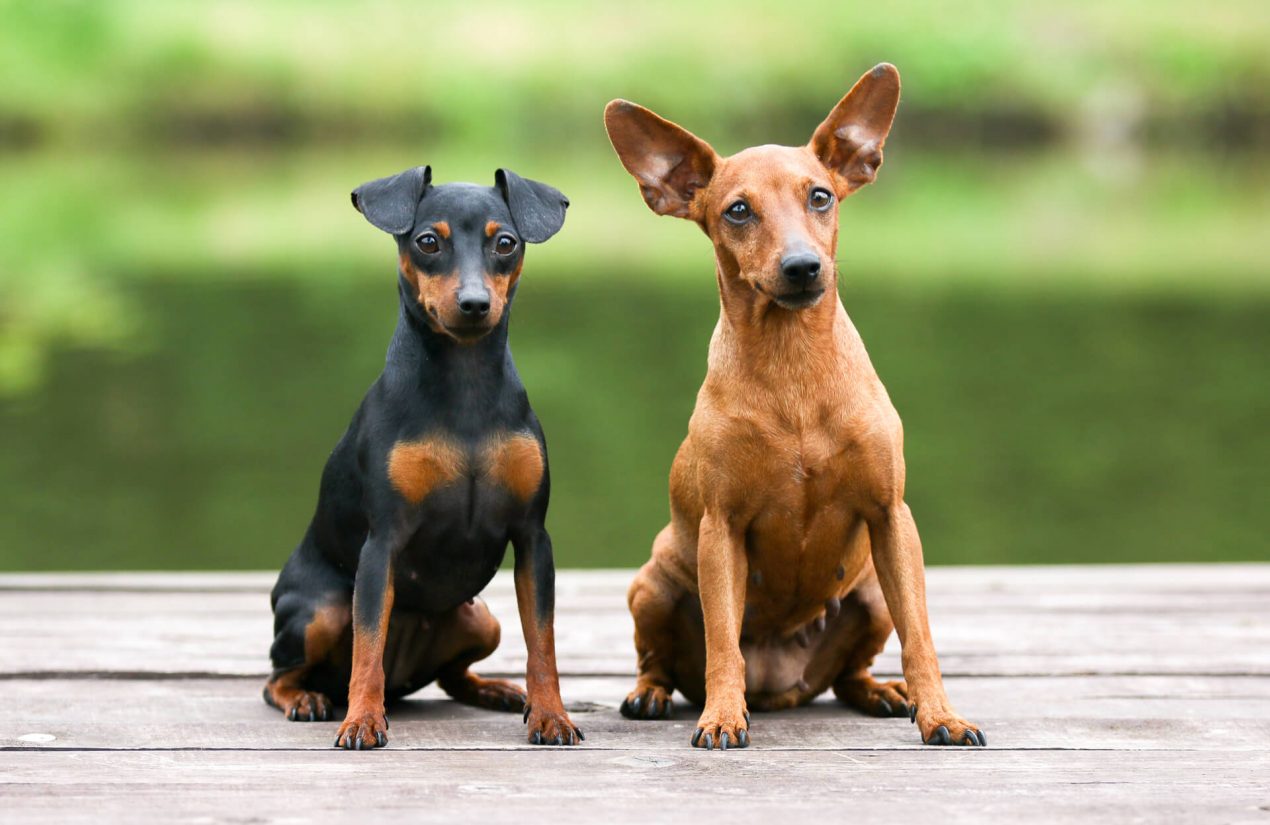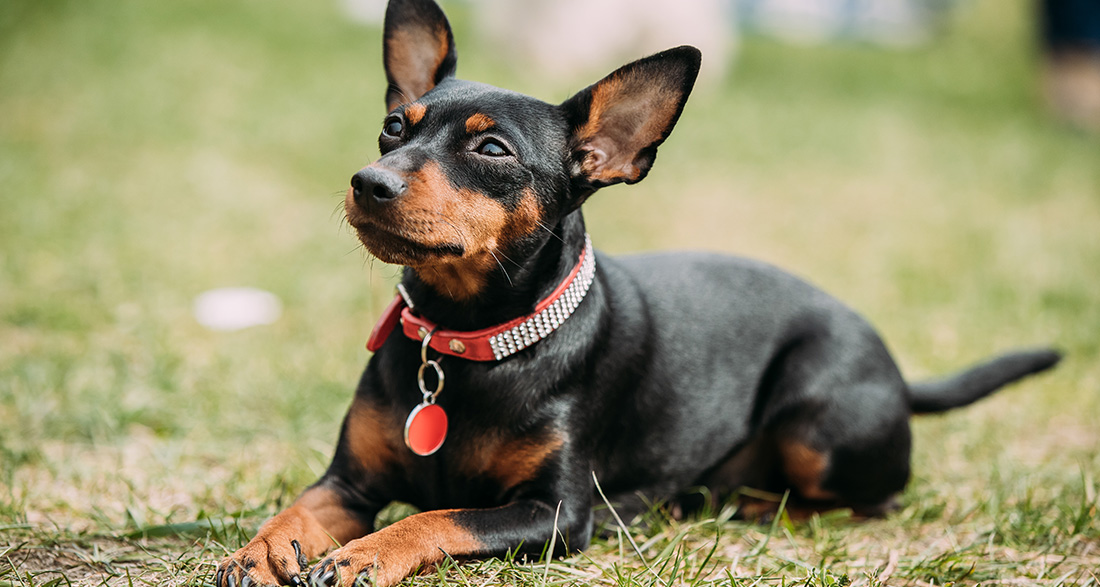The delicate and elegant Miniature Pinscher – affectionately called Minpin – is becoming increasingly popular due to its small size. This small dog is not a comfortable lapdog and wants to be taken just as seriously as its larger relatives. Here in the profile, you’ll learn everything about the origin, care, and grooming of these nimble dogs.
History of the Miniature Pinscher
The origin of all Pinschers lies in the so-called “Peat Dogs,” which were faithful companions of humans thousands of years ago. The dog helped people keep their homes and stables free from rats and other pests. Later, they were given a somewhat more honorable task of protecting travelers in carriages. Due to their alert and skillful nature, they remained very popular for keeping barns free of rats. Towards the end of the 19th century, farmers named the breed “Rattler.” The dogs came in both rough and smooth coats and various sizes.
Around 1870, breeders differentiated the dogs into the now well-known Pinscher and Schnauzer breeds. In 1895, Josef Berta called for the founding of the Pinscher-Schnauzer Club. The Miniature Pinscher quickly distinguished itself from its larger counterparts and became a popular companion dog in the city. Especially fine ladies liked to adorn themselves with a small Pinscher. The studbook from 1925 records 1300 entries. According to the FCI classification, the breed, together with the Doberman and the German Pinscher, belongs to FCI Group 2, Section 1.1 Pinschers.
Breed Overview
GROUP: Toy
HEIGHT: 10 to 12.5 inches
WEIGHT: 8 to 10 pounds
COAT: Short, shiny fur
COAT COLOR: Solid red, stag red (red with some black hairs), black with rust markings, chocolate with rust markings
LIFE SPAN: 12 to 16 years
TEMPERAMENT: Active, playful, intelligent, protective, brave
HYPOALLERGENIC: No
ORIGIN: Germany
Character and Temperament
The Miniature Pinscher is a curious, intelligent, and outgoing dog with high energy levels. Despite its small size, it is an attentive and enduring watchdog with a low threshold for stimulation. It is initially distrustful of strangers but quickly gains confidence. Without proper training or sufficient exercise, it can become vocal and prone to nervousness. Its innate hunting instinct emerges primarily with small animals and should not be underestimated. The affectionate and cuddly dog is strongly bonded to one person whom it prefers to accompany at all times. It is only moderately suitable for families with small children due to its small size. However, this lively dog is friendly and loves to play for hours.
| Affection Level | Medium |
| Friendliness | High |
| Kid-Friendly | Medium |
| Pet-Friendly | Medium |
| Exercise Needs | High |
| Playfulness | High |
| Energy Level | High |
| Trainability | Medium |
| Intelligence | High |
| Tendency to Bark | High |
| Amount of Shedding | Low |
Appearance of the Miniature Pinscher
The Miniature Pinscher has a square body, with height and length approximately equal. It has a muscular and elegant body with a shiny, smooth coat. The head is elongated with large, high-set V-shaped ears. There are specimens with both erect and floppy ears. The tail, if left natural, has a saber or sickle shape, but unfortunately, it is often docked. The coat is very short and smooth without an undercoat. Solid red, red-brown to dark red-brown, or two-toned black with red to brown markings are allowed as color variations. In summary, it is a “miniature version” of the larger Pinscher.

Puppy Training
The active Miniature Pinscher requires consistent training and comprehensive socialization during puppyhood. This prevents the small dogs from becoming aggressive barkers and makes them easy to lead. Thanks to their high intelligence and willingness to work, training is relatively easy for inexperienced dog owners. Playful training with plenty of mental and physical stimulation is key to success with these cheeky little dogs. They will become loving companions that you can take anywhere. Attending a puppy school is recommended so that the sociable dog can meet other dogs and doesn’t develop dominance issues later on. This allows them to express their personality within certain boundaries.
Activities with the Miniature Pinscher
Unlike other dogs of its size, the spirited and lively Miniature Pinscher has an extremely high need for exercise. It actively seeks engagement and is suitable for dog sports. Whether it’s agility, dog dancing, or obedience – physical activity is beneficial for these small dogs. They are always motivated to participate in all other sporting activities – from horseback riding to hiking and jogging. However, these dogs not only need physical but also mental stimulation. An under-exercised Pinscher has a low threshold for stimulation, becomes quickly nervous, and tends to bark.

Health and Care
The short and smooth coat of the Miniature Pinscher has no undercoat and is very easy to care for. It’s sufficient to occasionally groom and clean it from dirt. Unfortunately, this thin coat does not protect the dog in cold temperatures, and it can easily get cold. In extreme cases, frostbite can occur on the edges of the ears due to their large size. Therefore, in winter, you should not leave the Minpin outside for too long and consider putting on a coat, but not a costume. Miniature Pinschers are not particularly prone to typical small dog illnesses and are considered a very healthy breed. However, overbred specimens weighing less than four kilos suffer from numerous diseases, constant trembling, and have a shortened life expectancy.
Is the Miniature Pinscher Right for Me?
Before deciding on a Miniature Pinscher, make sure you have enough time to dedicate to the dog. Despite its small size, the dog needs a lot of exercise and attention to be happy. Keeping them in a small city apartment is quite possible as long as they get enough outdoor exercise during the day.
When looking for a breeder, membership in the Schnauzer-Pinscher Club is a good indicator of credibility. Do not engage with breeders who breed “Mini Miniature Pinschers” or “Prague Rattlers.” These dogs are excessively small and delicately bred, making them extremely prone to illness. They mostly come from mass breeding operations and are not officially recognized in the United States. Equally important is that the tails and ears of the puppies are left natural, as docking is prohibited. A healthy and purebred puppy costs around $1000.
Interesting Facts
The small Pinscher is a frequently appearing breed in literature. For example, the author Theodor Fontane mentions the Minpin as an eager rat and mouse catcher in his novel “Der Stechlin.” In the film adaptation of the novel “The Third Man,” actor Ernst Deutsch holds a Miniature Pinscher in one scene, which later becomes evidence of a conspiracy. Nowadays, these dogs are rarely seen on television as their lively nature does not make them particularly suitable as show dogs.
Do you have a Miniature Pinscher or are you considering getting one? Tell me in the comments what you think makes them so special!


